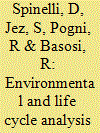| Srl | Item |
| 1 |
ID:
125435


|
|
|
|
|
| Publication |
2013.
|
| Summary/Abstract |
The Directive 2009/28/EC established the overall target that 20% of energy consumption should be represented by renewable energy sources by 2020 in each European member state. Furthermore, the Directive sets a mandatory 10% minimum target for biofuels in the transport sector.
Biofuels are potentially an important alternative to mineral diesel. We propose a pilot production line of biodiesel from sunflower on local scale in the Province of Siena (Tuscany) to research a possible reduction of fossil fuel consumption in the transport sector.
This study might represent an opportunity to reduce petroleum dependence in the transport sector.
Environmental Impact Indicators were provided by Material Flow Accounting, Embodied Energy Analysis and Emergy Accounting. Results showed that agricultural phase is the critical step in the production line.
A comparative Life Cycle Assessment analysis for the biodiesel production line with mineral diesel production showed environmental advantages of the biofuel production, however requiring a higher land demand. Therefore, biodiesel may not the optimal solution on large scale but might be a good alternative to fossil fuel. This would depend upon the entire production cycle taking place in a limited area. This is necessary in order to fulfill the needs of local farms and small enterprises.
|
|
|
|
|
|
|
|
|
|
|
|
|
|
|
|
| 2 |
ID:
091693


|
|
|
|
|
| Publication |
2009.
|
| Summary/Abstract |
In this paper, we evaluate energy efficiency in the European freight transport sector over three decades, according to a variety of indicators, methodologies and databases. The aim is, on the one hand, of determining major drawbacks in energy efficiency metrics, on the other hand, identifying a possible trend in the sector. The present analysis shows that energy efficiency evaluation is generally subject to misinterpretation and distortion with regard to the methods and data source adopted. Two different indicators (energy intensity and fuel economy) were initially taken into account to select the most suitable for evaluating vehicles' efficiency. Fuel economy was then adopted and measured according to two different methodologies (top-down and bottom-up). We then considered all the possible sources of distortion (data sources employed, methods of data detection, speed of detection, power enhancement, size factor) with the aim of accomplishing a sound estimation. Fuel economy was eventually divided with the maximum power available (adjusted fuel economy), to account for the power shift of vehicles, that represents a further efficiency improvement.
|
|
|
|
|
|
|
|
|
|
|
|
|
|
|
|